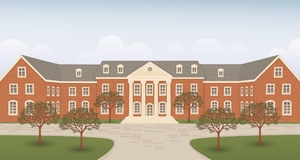Conceptualizing the Shared Governance Model in American Higher Education: Considering the Governing Board, President and Faculty
By
2013, Vol. 5 No. 12 | pg. 2/2 | « Conceptualizing the Faculty's RoleThe faculty’s role in the “shared governance” model is a dichotomy of classic and contemporary ideas. History shows that the model itself was created in order to curb the power of the traditionally powerful faculty, whose roots were in the colleges and universities of medieval Europe. Modern critics of an influential faculty seem to point to the issues of coordinating all opinions across departments, into one coherent voice. The “shared governance” model implies that all voices should be heard and respected. However, the faculty could also flounder in achieving short and long term goals because of their inability to reach a consensus (Tierney, 2003). On the other hand, the faculty plays an integral role in the model as the actors in charge of disseminating the core principles of an institution, to the customer (students). Therefore, their involvement in low/high level decision making integrates their knowledge of what works in a practical sense. The faculty sees their value as being a deliberate buffer against the encroachment of political influence, controversial policies, and diminished educational quality (Tierney, 2003). Additionally, the contemporary governance model dictates the faculty has its own compartmentalized responsibilities separate from the governing board or president. Kerr (2001) notes that while the influence of the faculty on governance and institutional policy has dropped, their influence on the academic quality of research and instruction has grown. The faculty in the “shared governance” model has a profound influence over content, instructional methods, department appointments, instruction and research (Gerber, 2001). Shifts in the faculty’s power and responsibilities work hand in hand with implementation and evolution of the model in the American context. The Faculty“The guilds of masters organized and ran the University of Paris and later they did the same at Oxford and Cambridge” - Kerr, 2001Mention of the faculty role in the “shared governance” model to a contemporary faculty member probably would elicit some melancholy regarding Kerr’s description given above. As it stands currently highlighted by the concepts above, the faculty role has been repurposed through the evolution of the “shared governance” model. Faculty contribution to the governance of institutions of higher education has undergone an evolution involving (3) separate steps from the University of Paris to contemporary universities in the United States. These steps include; total control, paternal control, and individual control. Total power was given, or taken, by the teaching guilds or “nations” of the University of Paris. The “rector” held power vested in him by the faculty to air student and faculty grievances, schedule classes and oversee collection of fees. Responsibility included leading meetings of the Arts faculty as a whole, course construction, degree requirements and certification of teachers (Lucas, 2006). Outside the realm of administration, the faculty still had a responsibility to teach and monitor student behavior in a highly regimented environment. Consequently, with exceptions at Bologna and later in the Reformation years, faculty excised total control in the majority of cases in the European model. Although in a different form, the aspect of quality control (academic and behavioral) shows a distinct connection between the roles of faculty in “shared governance” in contemporary institutions versus medieval ones. Oversight over student’s behavior notes the closeness of faculty members with the primary “customer,” which provided a traditional role for this group in the “shared governance” model. Paternal control is what defines the imported colonial faculty role from predecessors in Geneva, Ireland and Scotland. The archetype of “shared governance” distinguished the president as the internal arm of the board of trustees or visitors, a distinction which fostered a patriarchal model built on the tenants of mental discipline. Rules and regulations in like the eight page manual at Harvard in the 19th century were meant to be upheld by the faculty by strict and constant supervision. Combined with a fixed, classical education aimed at balancing ones emotions, intelligence and will, the paternal nature of the colonial and antebellum faculty member was codified (Veysey, 1965). Under a patriarchal president, the faculty served in this capacity to preserve the roots of classical European education. Before utilitarian and research efforts prevailed in American universities, strategic in-breeding ensured that control over the bastion of discipline and instruction remained in the hands of the faculty. The clear focus on faculty influence over instruction and curriculum in the historical context, provided foundation for their repurposed role in contemporary governance (Kerr, 2001). Individual control was a consequence of meeting the demand of outside forces from industry, politics and economics to serve a growing nation in the early to mid-19th century in the United States. As opportunities to inculcate new subject matter into the curriculum increased alongside opportunities for more students to attend institutions, the role of faculty in the governance model splintered once again. A broader network of administrators rounded out the mechanism of post-secondary higher education in a way that provided new opportunities for faculty members to focus on a combination of instruction and scholarship (Kerr, 2001). Having invested so much in the areas of instruction and research, the faculty member has drifted further from anything resembling a paternal enforcer of classical thought and behavior. The paternal qualities to preserve tradition, have given way to outside forces that break the traditional mold in search of innovation (Kerr, 2001). A reversal has indeed taken place as faculty members embrace outside demand to find their niche, as opposed to blocking off demand to maintain their niche. Gerber (2001) notes the parallel nature of increasingly specialized knowledge associated with new disciplines, determining the role of faculty in “shared governance.” Specialization dictates that the faculty becomes less concerned with the administration of broad institutional goals. Instead, issues related to teaching and the curriculum have become faculty concerns, which promoted the growth of academic departments and additional sub-administrations within an institution. ConclusionConstructing a hard definition for “shared governance” requires a historiographical approach concerning the governing board, the president and the faculty. This model has not gained popularity in a vacuum, and innovation and change in higher education consistently adds new dimensions to the original. Perhaps giving respect to trends such as the movement from “elite” to “universal” could provide an identifiable catalyst for the adjustments to this model. Having been immersed in the “universal” incarnation of higher education in the United States for the better part of 50 years, governance continues to change in functionality. Higher education itself has become an oxymoron, bringing a broader group of students closer together while distance is increasing between faculty and leadership. Additional contemporary trends such as totally online, for profit and distance education may continue to morph the “shared governance” model toward another paradigm shift. Internal and external adaptability defines American institutional governance. Delegating power between the governing board, the president, and the faculty in is imperative to the future implementation of effective models of shared governance. New models of institutions such as those outlined above, add a new look to the educational community that Kerr (2001) identifies. Contemporary trends such as these will continue to stress the framework of shared governance. New conceptions of the role of the governing board, president, and faculty will continue the evolution of institutional governance in the American context. ReferencesBrubacher, J. S., & Rudy, W. (1997).Higher education in transition: A history of American colleges and universities. Transaction Pub. Cohen, A. M. (2007).The shaping of American higher education: Emergence and growth of the contemporary system. Jossey-Bass. Cowley, W. H. (1980).Presidents, professors, and trustees. Jossey-Bass. Duryea, E. D. (1973). Evolution of university organization.Organization and Governance in Higher Education.(5th ed). United States of America: Pearson Custom Publishing. Gerber, L. G. (2001). " Inextricably linked": Shared governance and academic freedom. ACADEME-BULLETIN OF THE AAUP-, 87(3), 22-24. Ginsberg, B. (2011).The Fall of the Faculty: The Rise of the All-Administrative University and Why It Matters: The Rise of the All-Administrative University and Why It Matters. Oxford University Press, USA. Floud, R. (2007). Convergence and Diversity. Part I: EUA thematic working group papers, 23. Keohane, N. (1998). The American campus: from colonial seminary to global multiversity. Kerr, C. (2001).The uses of the university. Harvard University Press. Lucas, C. J. (1996).American higher education: A history. Palgrave MacMillan Metzger, W. P. (1969).Academic Freedom in the Age of the University(Vol. 12). Columbia University Press. Schachter, R. (2011). Twenty-first century challenges are threatening a bastion of faculty power and pride.University Business,14(8), 33-38. Thelin, J. R. (2011).A history of American higher education. Johns Hopkins University Press. Tierney, W. G., & Minor, J. T. (2003). Challenges for Governance: A National Report. Trombella, J. (2013).Evolution of university organization.Unpublished manuscript. Trow, M. (1985). Comparative reflections on leadership in higher education. European Journal of Education, 20(2/3), 143-159. Veysey, L. R. (1970).The emergence of the American university. University of Chicago Press. Zusman, A. (2005). Challenges facing higher education in the twenty-first century. American higher education in the twenty-first century: Social, political, and economic challenges, 2, 115-160. Suggested Reading from Inquiries Journal
Inquiries Journal provides undergraduate and graduate students around the world a platform for the wide dissemination of academic work over a range of core disciplines. Representing the work of students from hundreds of institutions around the globe, Inquiries Journal's large database of academic articles is completely free. Learn more | Blog | Submit Latest in Education |


















